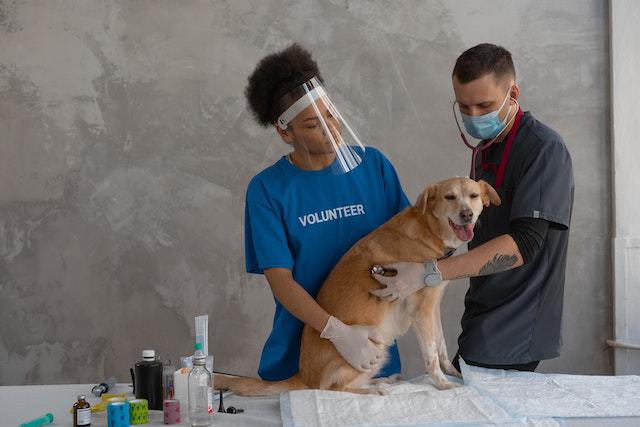9 Signs of Ear Mites in Dogs & Treatment Options

Hey there fellow dog parents! Let’s talk about a pesky little problem that can drive our furry friends crazy – ear mites in dogs.
These tiny critters can cause major discomfort for our pups, but fear not, because in this article, we’ll dive into what ear mites are, how to spot them, and most importantly, how to get rid of them.
So, let’s get started!
What are Ear Mites in Dogs?
Ear mites are microscopic parasites that infest the external ear canal of dogs, they can cause itching, discomfort, and inflammation in and around the ears.
If left untreated, ear mites can lead to partial or total deafness in dogs.
These tiny parasites can easily spread to other pets, so it’s important to diagnose and treat them promptly with the help of a veterinarian.
Life Cycle of Ear Mites in Dogs
Ear mites, known as Otodectes cynotis, are common parasites that infest the ears of dogs. The life cycle of ear mites typically lasts for about three weeks.
Female mites lay eggs in the dog’s ear canal, which hatch into larvae within four days. The larvae then feed on earwax and skin debris before developing into nymphs.
Nymphs mature into adult mites, which reproduce and continue the cycle. Regular cleaning and treatment are essential to prevent the spread and recurrence of ear mites in dogs.
Signs of Ear Mites in Dogs
Ear mites are a common parasitic infestation that can affect dogs. Here are some signs that your dog may have ear mites:
- Ear Scratching: Dogs with ear mites often scratch at their ears excessively. They may use their paws or rub their ears against furniture or the floor.
- Head Shaking: Another common sign of ear mites is frequent head shaking. Dogs may vigorously shake their heads as a way to relieve the itchiness and discomfort caused by the mites.
- Dark Discharge: Ear mites can cause the production of a dark, waxy discharge in the affected ear. This discharge may have a foul odor and can be seen when examining the ear.
- Skin Lesions: Dogs with ear mites may develop skin lesions around the ears. These lesions can be red, inflamed, or crusty, and may be a result of the dog scratching or rubbing the affected area.
- Hair Loss: In some cases, ear mites can cause hair loss around the ears. This can occur due to the dog’s scratching or as a result of the mites themselves.
- Irritability: Dogs with ear mites may become irritable or agitated. The constant itching and discomfort can affect their behavior and mood.
- Tilting of the Head: If the ear mite infestation is severe, it can lead to inflammation and irritation of the ear canal, causing the dog to tilt its head to one side.
- Visible Mites: In some cases, you may be able to see the ear mites themselves. Ear mites are tiny, white, spider-like creatures that can sometimes be seen moving inside the ear.
- Scabs and Crusts: Due to the constant scratching and irritation, dogs with ear mites may develop scabs and crusts around the ears.
It’s important to note that these signs can also be indicative of other ear conditions, so it’s best to consult a veterinarian for a proper diagnosis and treatment plan if you suspect your dog has ear mites.
Read more about why your dog is shaking.
How do dogs get ear mites?
Dogs can get ear mites through direct contact with other infected animals. Ear mites are highly contagious and can easily spread from one dog to another.
Let’s dig deeper…
Here are some common ways dogs get ear mites:
1. Direct Contact with Infested Animals: Ear mites are highly contagious and can easily spread from one animal to another through direct contact. If your dog comes into contact with another dog, cat, rabbit, or ferret that has ear mites, they can get infected as well.
2. Shared Living Spaces: Dogs living in close quarters, such as kennels, shelters, or multi-pet households, are at an increased risk of contracting ear mites. The mites can easily spread from one animal to another if they share the same living space.
3. Outdoor Exposure: Dogs that spend a lot of time outdoors, especially in areas where other infested animals frequent, are more likely to come into contact with ear mites. These mites can survive in the environment for a limited time, so outdoor exposure can increase the risk of infestation.
4. Grooming and Boarding Facilities: Dogs that visit grooming salons or boarding facilities have a higher chance of encountering ear mites. These facilities often have multiple animals coming and going, which increases the risk of mite transmission.
5. Maternal Transmission: Puppies can acquire ear mites from their mother during birth or through close contact during nursing. If the mother dog has ear mites, the mites can easily transfer to the puppies.
6. Indirect Transmission: Ear mites can also be indirectly transmitted through contaminated objects, such as bedding, toys, or grooming tools. If an infested animal has come into contact with these objects, the mites can survive and potentially infect other dogs.
Read more about the health concerns in dogs.
Diagnosing Ear Mites in Dogs
Diagnosing ear mites in dogs is typically done through a combination of visual examination and microscopic analysis.
Veterinarians will inspect the dog’s ears for signs of mites, such as redness, swelling, and dark discharge.
A sample of the discharge may be collected and examined under a microscope to confirm the presence of mites. In some cases, a veterinarian may use an otoscope to get a closer look at the ear canal.
Prompt diagnosis is essential to prevent further discomfort and to initiate appropriate treatment for the affected dog.
Treatment Options for Ear Mites in Dogs
Ear mites in dogs can be effectively treated with various treatment options. Here are some treatment options for ear mites in dogs:
- Topical Medications: Topical medications are commonly used to treat ear mites in dogs. These medications are applied directly to the affected area, typically the ear canal. They work by killing the adult mites and their eggs. Examples of topical medications include Revolution, Advantage Multi, and Milbemite. Your veterinarian will determine the most appropriate topical medication based on your dog’s specific needs.
- Prescription Ear Drops: Prescription ear drops are another common treatment option for ear mites in dogs. These drops contain medications that kill the mites and help alleviate the associated symptoms. Your veterinarian may prescribe ear drops such as ivermectin or other suitable medications based on the severity of the infestation.
- Oral Medications: In some cases, oral medications may be prescribed to treat ear mites in dogs. These medications are typically in tablet or liquid form and are administered orally. They work systemically to kill the mites throughout the dog’s body. Examples of oral medications include ivermectin and fluralaner.
- Injections: In severe cases or when other treatment options are not effective, injections of medications may be recommended. One such injection is ivermectin, which is administered by a veterinarian and works to kill the mites. It’s important to follow your veterinarian’s instructions for proper dosage and administration.
- Cleaning the Ears: Cleaning the ears is an important part of the treatment process for ear mites in dogs. This helps remove debris and mites from the ear canal and allows the medications to penetrate effectively. Your veterinarian may recommend specific ear cleaning solutions or provide instructions on how to clean your dog’s ears properly.
- Treating Other Pets in the Household: If you have multiple pets in your household, it’s crucial to treat all of them for ear mites, even if they don’t show symptoms. Ear mites are highly contagious, and treating all pets helps prevent reinfestation. Consult with your veterinarian to develop a comprehensive treatment plan for all the pets in your home.
It’s important to note that the specific treatment plan for your dog may vary depending on factors such as the severity of the infestation, your dog’s overall health, and any underlying conditions.
It’s always best to consult with your veterinarian for an accurate diagnosis and to determine the most appropriate treatment options for your dog’s specific needs.
Home Remedies for Ear Mites in Dogs
Here are some home remedies for ear mites in dogs:
1. Green Tea: Green tea is a natural antiseptic that can help get rid of ear mites. Steep a tea bag or a tablespoon of loose green tea in a cup of hot water for a few minutes, then strain and let it cool to room temperature. Use a dropper to put 3-4 drops of tea in each ear, massage your dog’s ears gently, and then dip a cotton ball in the tea and wipe inside her ears. Do this once a day for 4 weeks.
2. Mineral Oil: Put two to three drops of mineral oil in each ear of your dog. Lay your dog over on their side and try to get them to relax. Do this once a day for a week.
3. Olive Oil: Olive oil can help get debris out of your dog’s ears. Put a few drops of olive oil in each ear and massage the base of the ear to help work the oil in. Do this once a day for a week.
4. Hydrogen Peroxide: Hydrogen peroxide has mild antiseptic properties and can help flush out ear mites. Mix equal parts of hydrogen peroxide and water, and use a dropper to put a few drops in each ear. Massage the base of the ear to help work the solution in. Do this once a day for a week.
Read more about identifying a dog in pain.
Preventing Ear Mites in Dogs
Ear mites are a common problem in dogs, but there are several ways to prevent infestations and keep your furry friend’s ears healthy.
Here are some common ways to prevent ear mites in dogs:
1. Regular ear cleaning: Clean your dog’s ears regularly to remove any dirt, wax, or debris that could attract mites. Use a gentle ear cleaner recommended by your veterinarian and follow the instructions for proper use.
2. Avoid excessive moisture: Keep your dog’s ears dry, as moisture can create an environment where mites thrive. After swimming or bathing, make sure to thoroughly dry your dog’s ears.
3. Check for signs of infestation: Regularly inspect your dog’s ears for any signs of ear mites, such as excessive scratching, head shaking, or dark discharge. If you suspect an infestation, consult your veterinarian for proper diagnosis and treatment.
4. Avoid contact with infested animals: Ear mites are highly contagious, so it’s important to prevent your dog from coming into contact with animals that have ear mites. Be cautious when introducing your dog to new pets or environments.
5. Maintain good overall hygiene: Keeping your dog clean and healthy can help prevent ear mite infestations. Regular grooming, including brushing and bathing, can help keep mites at bay.
6. Treat other parasite infestations: Some parasites, such as fleas, can contribute to ear mite infestations. Use appropriate flea and tick prevention methods to prevent these pests from bothering your dog.
7. Avoid sharing bedding and toys: If you have multiple pets, avoid sharing bedding, toys, or other items that could potentially spread ear mites. Wash and disinfect these items regularly to minimize the risk of infestation.
8. Regular veterinary check-ups: Schedule regular check-ups with your veterinarian to monitor your dog’s overall health, including their ears. Your vet can help detect and treat any potential issues, including ear mite infestations.
9. Follow preventive measures: Some preventative medications, such as certain topical treatments or oral medications, can help protect your dog against ear mites. Consult your veterinarian to determine the most appropriate preventive measures for your dog’s individual needs.
Remember, prevention is key when it comes to ear mites. By following these common preventive measures, you can help keep your dog’s ears healthy and free from ear mite infestations.
Read more about caring for your dog.
Conclusion
So, remember, if you notice your furry friend scratching their ears more than usual or shaking their head excessively, it could be a sign of those pesky ear mites.
Don’t worry though, with proper treatment and regular ear cleanings, you can keep your pup’s ears mite-free and their wagging tails happy. Stay vigilant and give your pup the care they deserve!






